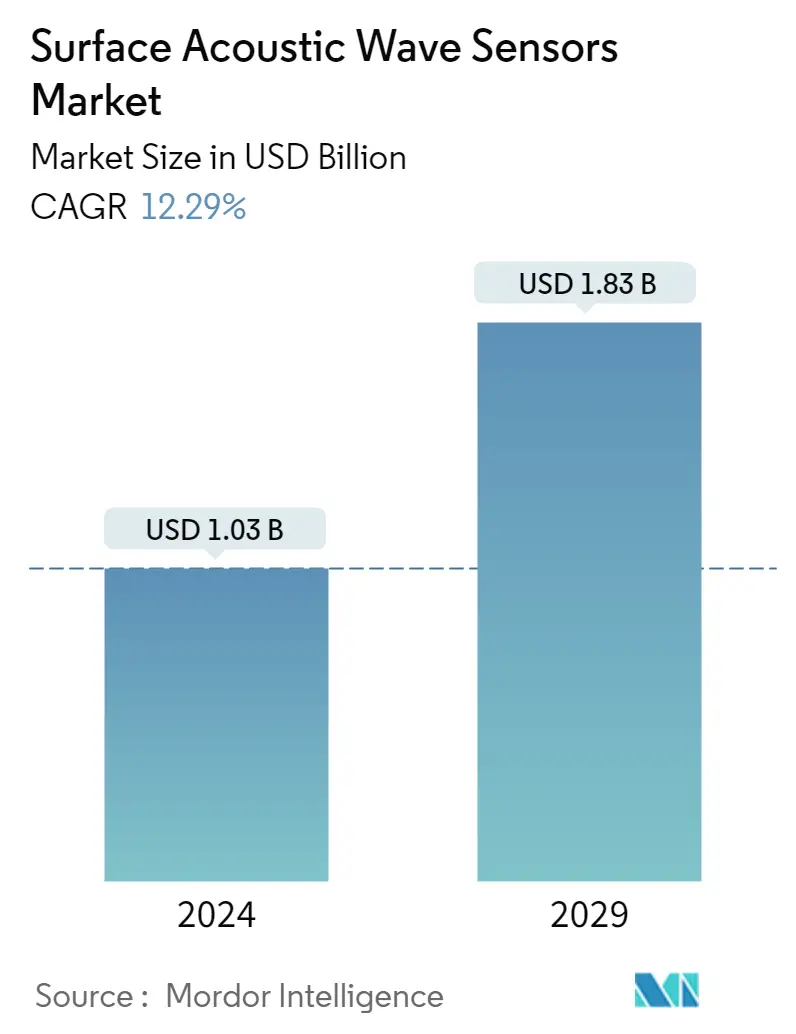Market Size of Surface Acoustic Wave Sensors Industry

| Study Period | 2019 - 2029 |
| Market Size (2024) | USD 1.03 Billion |
| Market Size (2029) | USD 1.83 Billion |
| CAGR (2024 - 2029) | 12.29 % |
| Fastest Growing Market | North America |
| Largest Market | Asia Pacific |
| Market Concentration | Medium |
Major Players
*Disclaimer: Major Players sorted in no particular order |
Surface Acoustic Wave Sensors Market Analysis
The Surface Acoustic Wave Sensors Market size is estimated at USD 1.03 billion in 2024, and is expected to reach USD 1.83 billion by 2029, growing at a CAGR of 12.29% during the forecast period (2024-2029).
Due to their small size, rugged nature, economical production, stability in operation, and applications across various end-user industries, the surface acoustic wave sensors make them an increasingly adopted sensor technology during the forecast period.
- Surface acoustic wave (SAW) technology has been significantly adopted across some industry applications, including aerospace, telecommunication, and automotive. The most common use is in electronic components known as SAW filters, a basic radio frequency (RF) circuit component. SAW devices have also been utilized to measure humidity, pressure, and temperature and detect certain chemicals.
- With advancements in the communication sector, SAW and bulk-acoustic-wave (BAW) resonators, filters, oscillators, and delay lines have gained traction. Apart from being passive and wirelessly interrogated, SAW sensors are competitively priced, intrinsically rugged, highly responsive, and intrinsically reliable.
- The automotive, defense, and aerospace industries are also attracting vendors in the market studied in recent years. As these sensors are insensitive to Magnetic Fields, many automotive applications require torque-sensing close to electric motors and solenoids. This is problematic for some other types of sensor technology.
- In the initial phase of COVID-19, the studied market witnessed a disruption in the supply chain owing to a nationwide lockdown and closure of many manufacturing capacities. However, after Q2 2020, the market started witnessing a recovery in demand and in production, the trend of the semiconductor industry was also reflected in the studied market. However, trends like electric vehicles and mandating safety features in automotive are increasing the per vehicle semiconductor content, which will help the SAW sensors demand to overcome the impact in the coming months.
- Researchers specializing in SAW sensors are actively seeking opportunities to partner with non-destructive testing solution providers in a bid to check the feasibility and ultimately open new application areas for these sensors. For instance, in partnership with NYIT's School of Engineering and Computing Sciences, the NDT solution provider for the aerospace and defense industry, X-Wave Innovations Inc., announced to work for NASA to develop an embedded sensor system capable of measuring temperature, pressure, and other stimuli affecting rocket propulsion engine systems. The project was also awarded funding of over USD 125,000 by NASA.
Surface Acoustic Wave Sensors Industry Segmentation
Surface acoustic wave (SAW) sensors are primarily used for the identification and measurement of physical parameters such as pressure, temperature, acceleration, torque, tire-road friction, humidity, etc. These sensors are used in various end-user industries based on the requirements.
The Surface Acoustic Wave Sensors Market is segmented by Sensing Type (Pressure Sensors, Torque Sensors, Viscosity Sensors), End-user Industry (Automotive, Consumer Electronics, Industrial), and Geography.
| Sensing Type | |
| Pressure Sensors | |
| Torque Sensors | |
| Temperature Sensors | |
| Humidity Sensors | |
| Chemical Sensors | |
| Other Sensors |
| End-User Industry | |
| Automotive | |
| Aerospace and Defense | |
| Consumer Electronics | |
| Healthcare | |
| Industrial | |
| Other End-User Industries |
| Geography | |
| North America | |
| Europe | |
| Asia Pacific | |
| Rest of the World |
Surface Acoustic Wave Sensors Market Size Summary
The Surface Acoustic Wave (SAW) Sensors Market is poised for significant growth, driven by their compact size, durability, cost-effectiveness, and versatility across various industries. These sensors are increasingly being adopted in sectors such as aerospace, telecommunications, and automotive, primarily due to their application in electronic components like SAW filters and their ability to measure humidity, pressure, and temperature. The market is experiencing a surge in demand, particularly in the automotive and defense industries, where SAW sensors' insensitivity to magnetic fields makes them ideal for applications near electric motors and solenoids. Despite initial disruptions during the COVID-19 pandemic, the market has shown resilience and is expected to benefit from trends like electric vehicles and enhanced safety features in automobiles, which are increasing the semiconductor content per vehicle.
In the healthcare sector, the demand for SAW sensors is driven by the need for low-cost, flexible, and wireless monitoring solutions. These sensors are being integrated into Point of Care testing devices and wearable biosensors, facilitating rapid and accurate diagnostic capabilities. The healthcare industry's investment in biosensors and MEMS is further propelling the adoption of SAW technology, especially for applications such as cancer detection, ECG monitoring, and neonatal care. The North American region, particularly the United States, is a key market due to its technological advancements and diverse industrial applications. The region's growth is supported by innovative research and development activities, making it a lucrative market for SAW sensor manufacturers. The market is moderately competitive, with key players focusing on product innovation and strategic partnerships to maintain their competitive edge.
Surface Acoustic Wave Sensors Market Size - Table of Contents
-
1. MARKET DYNAMICS
-
1.1 Market Overview
-
1.2 Market Drivers
-
1.2.1 Wireless and Passive Nature of Sensors
-
1.2.2 Low Manufacturing Cost
-
-
1.3 Market Restraints
-
1.3.1 Compatibility and Installation Issues
-
1.3.2 Limitations in Liquid Sensing
-
-
1.4 Industry Attractiveness - Porter's Five Forces Analysis
-
1.4.1 Threat of New Entrants
-
1.4.2 Bargaining Power of Buyers
-
1.4.3 Bargaining Power of Suppliers
-
1.4.4 Threat of Substitute Products
-
1.4.5 Intensity of Competitive Rivalry
-
-
-
2. MARKET SEGMENTATION
-
2.1 Sensing Type
-
2.1.1 Pressure Sensors
-
2.1.2 Torque Sensors
-
2.1.3 Temperature Sensors
-
2.1.4 Humidity Sensors
-
2.1.5 Chemical Sensors
-
2.1.6 Other Sensors
-
-
2.2 End-User Industry
-
2.2.1 Automotive
-
2.2.2 Aerospace and Defense
-
2.2.3 Consumer Electronics
-
2.2.4 Healthcare
-
2.2.5 Industrial
-
2.2.6 Other End-User Industries
-
-
2.3 Geography
-
2.3.1 North America
-
2.3.2 Europe
-
2.3.3 Asia Pacific
-
2.3.4 Rest of the World
-
-
Surface Acoustic Wave Sensors Market Size FAQs
How big is the Surface Acoustic Wave Sensors Market?
The Surface Acoustic Wave Sensors Market size is expected to reach USD 1.16 billion in 2025 and grow at a CAGR of 12.29% to reach USD 2.06 billion by 2030.
What is the current Surface Acoustic Wave Sensors Market size?
In 2025, the Surface Acoustic Wave Sensors Market size is expected to reach USD 1.16 billion.

